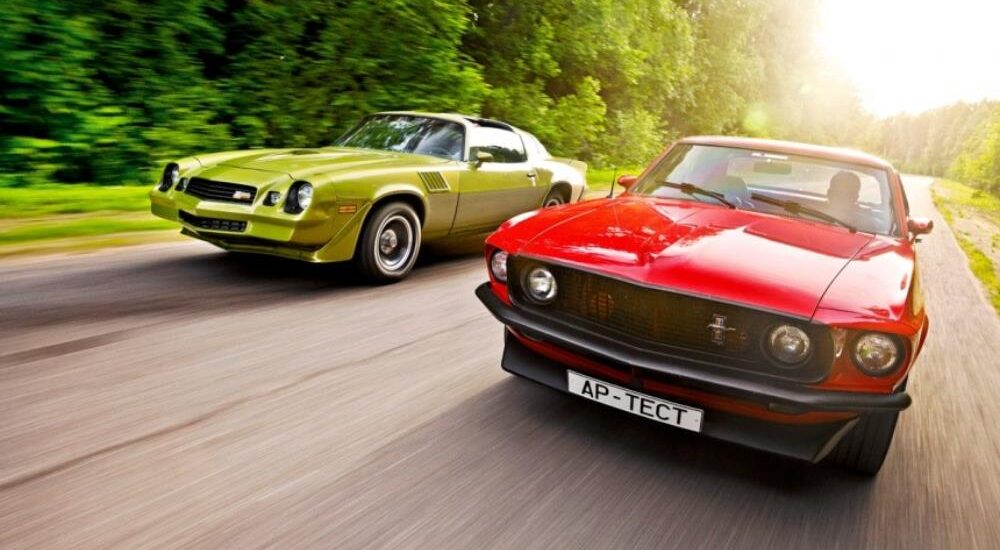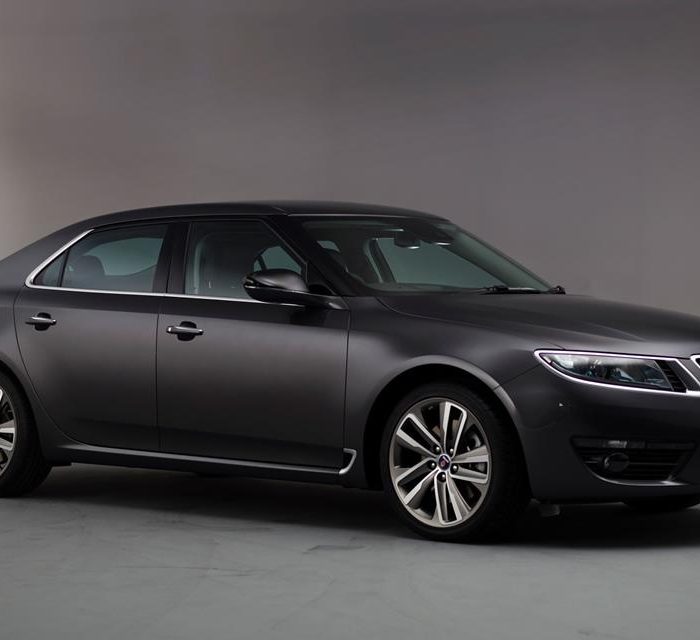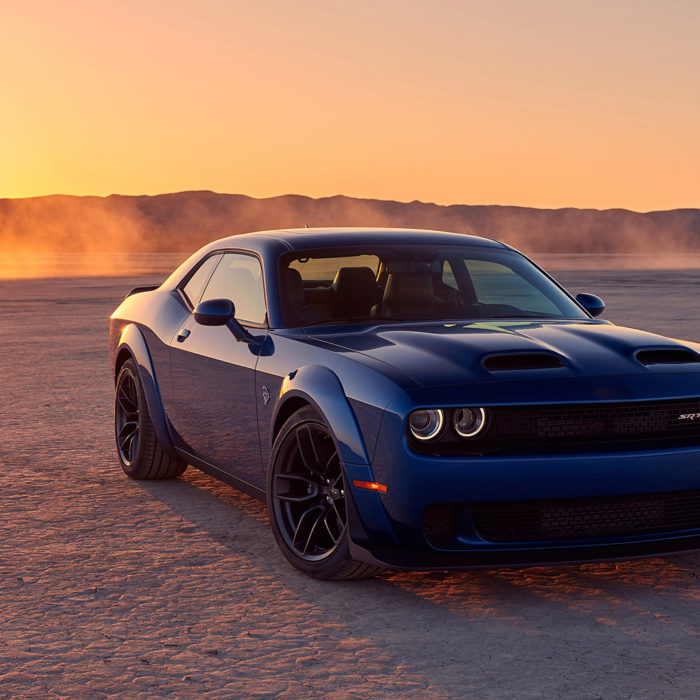Under the long expanse of the hood, the V8 engine performs a concert with an orchestra. The long air filter snorkel hums, the throttle linkage in the carburetor moans, and the rhythm section thumps in the muffler. Hollywood stars on the track! Between them, they have 16 cylinders, almost 11 liters of displacement, and a mere 400 horsepower. Only six gears, but five meters wide egos. To feel cool, it’s enough just to stand next to them, because these are Mustang and Camaro. Fifty-year-old Mustang and Camaro. Yet is it worth driving?
Looking at the first-generation Ford Mustang, it’s clear that a beautiful car is a dangerous car. There is an allure in risk – just like this cherry-red coupe, rumbling with exhaust. The project itself was risky: Ford executive Lee Iacocca staked his future and reputation on the Mustang. The company was still reeling from the failure of the Edsel models, but the visionary Iacocca convinced the company’s head, Henry Ford II, that customers wanted flashy looks at a minimal price. By the mid-60s, the maturing children born during the post-war baby boom began to have a serious influence on car choices: they didn’t want their parents driving old folks’ cars.
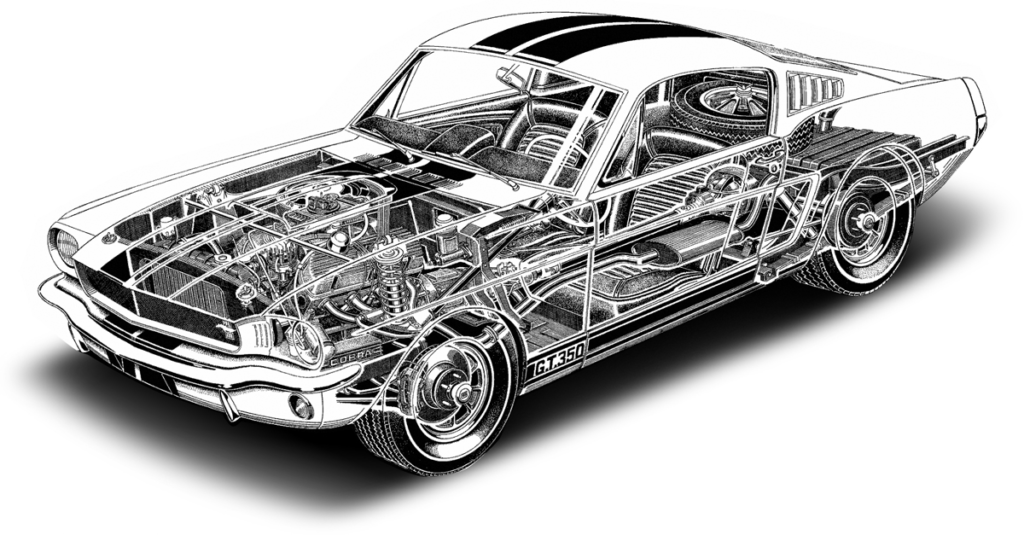
Beneath its flashy exterior lies a mundane chassis from a regular sedan. What’s more, the illustration features a non-factory Shelby GT350 version with a 4.7-liter engine producing around 300 horsepower. Pony cars in general were known for their versatility: the basic chassis layout remained unchanged, but in addition to over a dozen different engines and several transmission options, one could choose the final drive ratio, and the suspension could be adjusted for different versions. Even the steering box had an option: the base ratio was 25.3:1 or a quicker one at 22:1.
The Mustang’s debut in April 1964 was staggering. No new car in history had ever become so popular in its first year of production: a million coupes were sold by early 1966! The ingenious design by David Ash and a starting price of $2,300 performed a marketing miracle. With the average salary being $400, the Mustang was attainable for almost everyone: it was the most affordable car with a sporty image on the market.
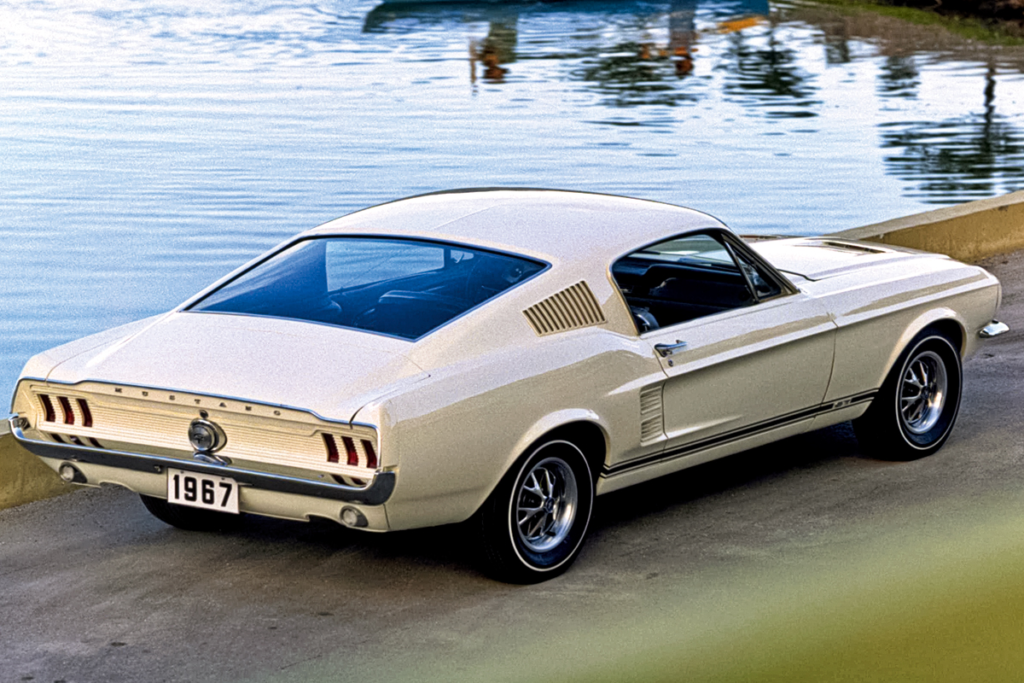
The Mustang could be more than just a regular coupe; it could also be a convertible or a fastback – the very body with this sloping roofline became the film star.
Its creed was to seem rather than to be, as no serious engineering was planned at such a price. The Mustang was a flashy cover for the boring Ford Falcon sedan, which had debuted back in 1960. And the engines and transmissions were shared across the company’s range. Therefore, the Mustang’s success was solely due to its looks. And this was only possible in the US during the last five years of low fuel prices.

Our car is from the breakdown of that golden era: a 1969 model, with a 5.0-liter engine producing 223 horsepower and a three-speed manual transmission. The perfect balance between the basic 90-horsepower inline-six and the Boss, Mach 1, and Cobra Jet 428 versions with a seven-liter V8 engine pumping out nearly four hundred horses! The door handle has a large button, like on the Moskvich 412, but behind it… Such an interior wasn’t even available in the Volga. Beautiful seats, soft door upholstery, and a pair of wide “eyebrows” on the dashboard under which the instruments and glovebox hide. The gauges are so deeply recessed that you have to peer closely from the driver’s seat. The seating position somewhat resembles that in a Lada: legs astride, the seatback ends before reaching the shoulder blades. But when you turn the small ignition key and the engine awakens the eight cylinders with a noticeable vibration, all comparisons to Soviet passenger car production vanish along with the rat-a-tat sound from the exhaust pipes.

The 302 engine (cubic inches in displacement) was one of the smallest among the V8s. The brace between the fenders and the struts connecting the firewall to the top shock absorber mounts.
The Mustang is like a riled-up ZIL (a Soviet-era heavy vehicle brand). The front suspension features double wishbones, while the rear has a solid axle with leaf springs. Power steering is present, and it takes almost four and a half turns from lock to lock. You have to depress the pedals with an unnatural flexing of the foot, but the gear shifter has a precise feel, albeit stiff. First gear is where second gear is usually found on most cars. This gear layout resonates with the Getrag gearbox on the BMW M3 E30 series, but the primary association is still with a truck, as the ZIL usually starts in second gear in normal conditions.
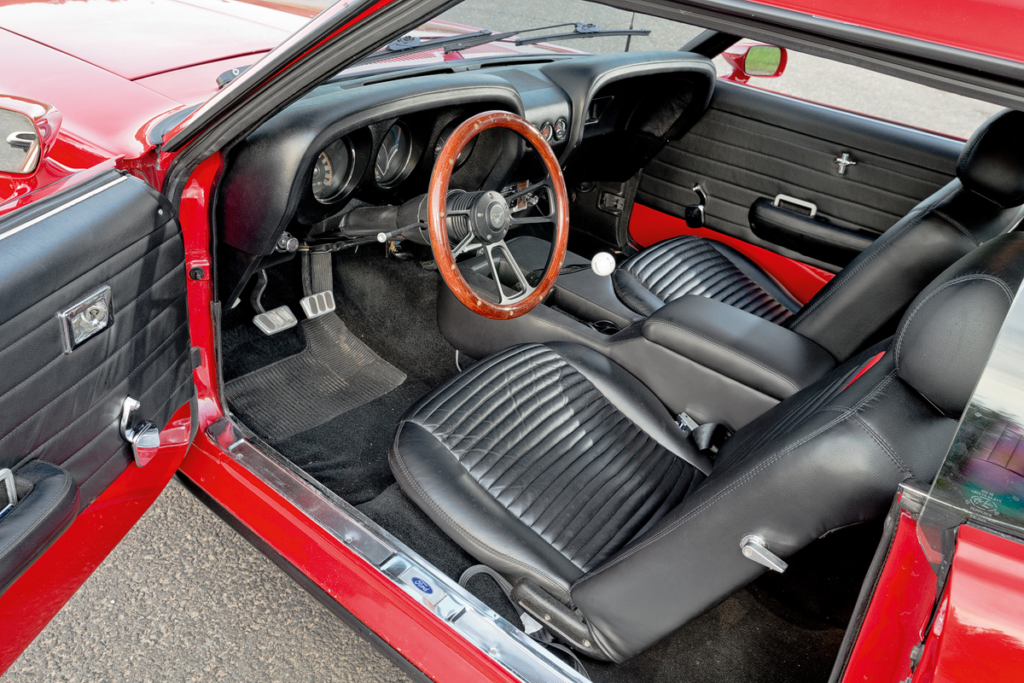
The black interior isn’t the only option, as there’s a wide range of colors available. The materials are tactilely pleasant, with plenty of vinyl. The low seating position leaves ample headroom, but the knees are highly bent, and the seat belt is lap-only.
The clutch travel is huge, and the accelerator pedal is heavy, so there’s no room for sentiment. You’d want to pull away like Steve McQueen in the movie Bullitt, with a long burnout from the single spinning wheel. There’s an open differential, and more than 400 Nm of torque is enough to lay down rubber even with modern wide tires.
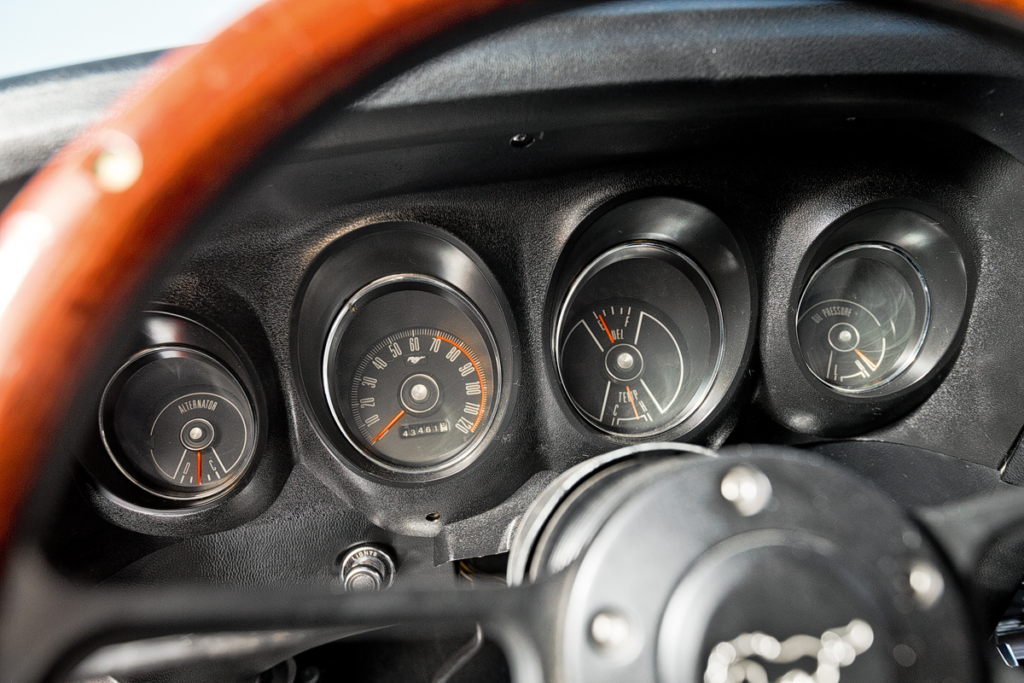
The Mustang of the first generation had instruments that changed almost every year and by the end of its life cycle, they weren’t very informative. The best version was the 1967 model, with two large speedometer and tachometer dials and secondary gauges on the top row.
The need to shift gears quickly starts to feel archaic. With such poor ergonomics and a clumsy pedal setup, you’ll long for an automatic transmission – it seems like the Americans were forcibly switched to vehicles with automatics. However, the engine allows you to stay in third gear most of the time. If you manage to dance on the pedals correctly and hit all the gears, you can reach 100 km/h (62 mph) in 12 seconds. The fastest Mustangs, according to official data, could do it in six seconds. But I didn’t enjoy revving this engine to its limit. Somewhere close to 4,000 rpm, the growl of the V8 turns into the dry mechanical noise of a big engine – and the charm of the Mustang disappears completely.
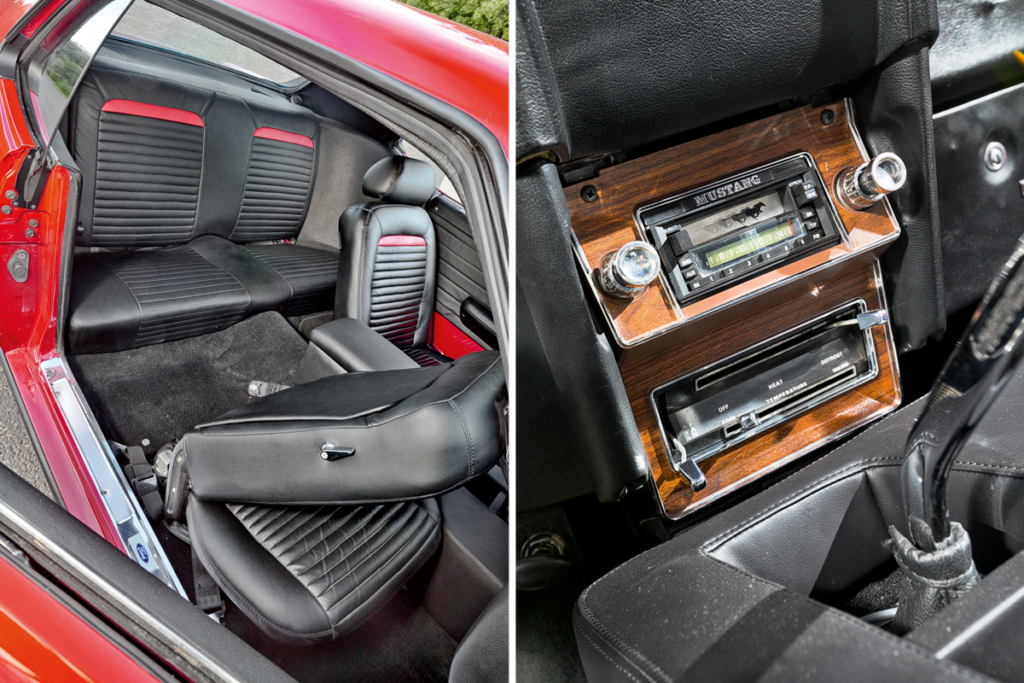
Note that the seatback not only reclines but also shifts sideways for easier access to the rear seats. However, it’s more cramped in the back than in a Moskvich 412.
With a starting price of around $2,500, on average, the buyer added $500 for options. For example, a stereo with the ability to play audio cassettes for $134, and an FM receiver that cost even more – $181. The most extravagant option was the air conditioner for $381. Even the 335-horsepower engine was cheaper.
A contradictory car. No wonder that 1972, when the first-generation Mustangs were most prevalent on American roads, remains a sad record holder for the number of victims in car accidents. The Mustang became not only an icon, a movie character, and a symbol of an era, but also a real threat to the nation. Crashing this car is not a challenging task; it lacks any form of passive safety measures. Lap belts will only help forensic experts not to look for you beyond the wreckage, but the survivors are unlikely to make up for the loss, as the rear seat is too small and the roof is not high. During the years of the Mustang’s super-popularity, the fertility rate in America was the lowest in history.
Behind the wheel of a Mustang, you hardly think about anything else – the main challenge is to make it turn! On one hand, such stubbornness is great because there’s no danger of suddenly skidding. But on the other hand, in case of an emergency, you become a passenger. And the brakes here aren’t much of a help, they’re more of a consolation.

Talking about balance in the corners is premature: the Mustang won’t have it for another 45 years, not until it gets a multi-link rear suspension. That’s why it’s best to consider the bends as just a pause between the engine’s songs on the straights. Ford doesn’t have many problems with that. Yes, the axle hops left and right over bumps, but maintaining 60 mph is not difficult. All that’s left for you is to put on a serious face, wear aviator sunglasses, and drive into the sunset, leaving behind problems, loved ones, unburnt 92 octane, and one of the best sounds that human creation can make. You can forgive it all for the fact that the Mustang doesn’t suppress you, but inflates your ego across its five-meter length from the front to the rear bumper!
Except for those darn pedals, which make you look with double interest in the direction of the Camaro.
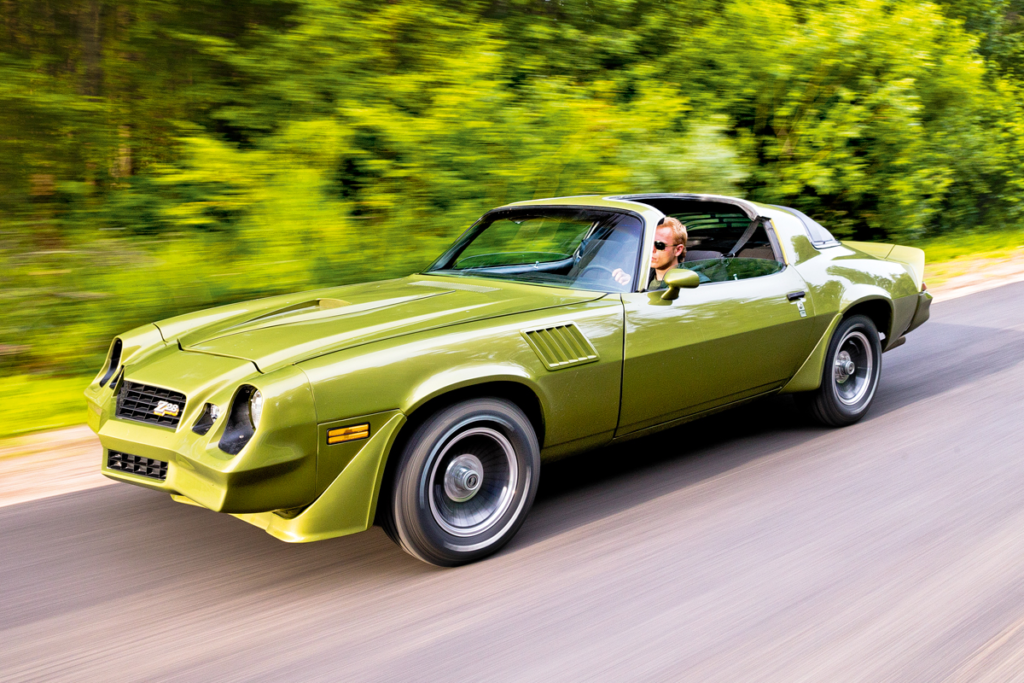
The birth and development of the Chevrolet pony car was a Mustang chase. Life itself wrote the script for their cinematic races. General Motors missed Ford’s super debut and only prepared a response by 1967. From an engineering point of view, this project was a carbon copy of the Mustang: the chassis of the mass-market Chevrolet Nova sedan was covered with a stylish two-door body. Luckily, the Nova had just debuted and was considered advanced by American standards: leaf springs and an axle in the rear, of course, but the front double wishbone suspension was mounted on a subframe. Moreover, the Camaro became the company’s first car whose body was seriously tested in the wind tunnel of aviation company Ling-Temco-Vought (GM got its own laboratory in 1980). The engines were shared by the sibling Chevelle: the lineup was opened by a six-cylinder engine with 140 hp, and at the top was a big-block V8 with a seven-liter capacity, producing 425 hp!
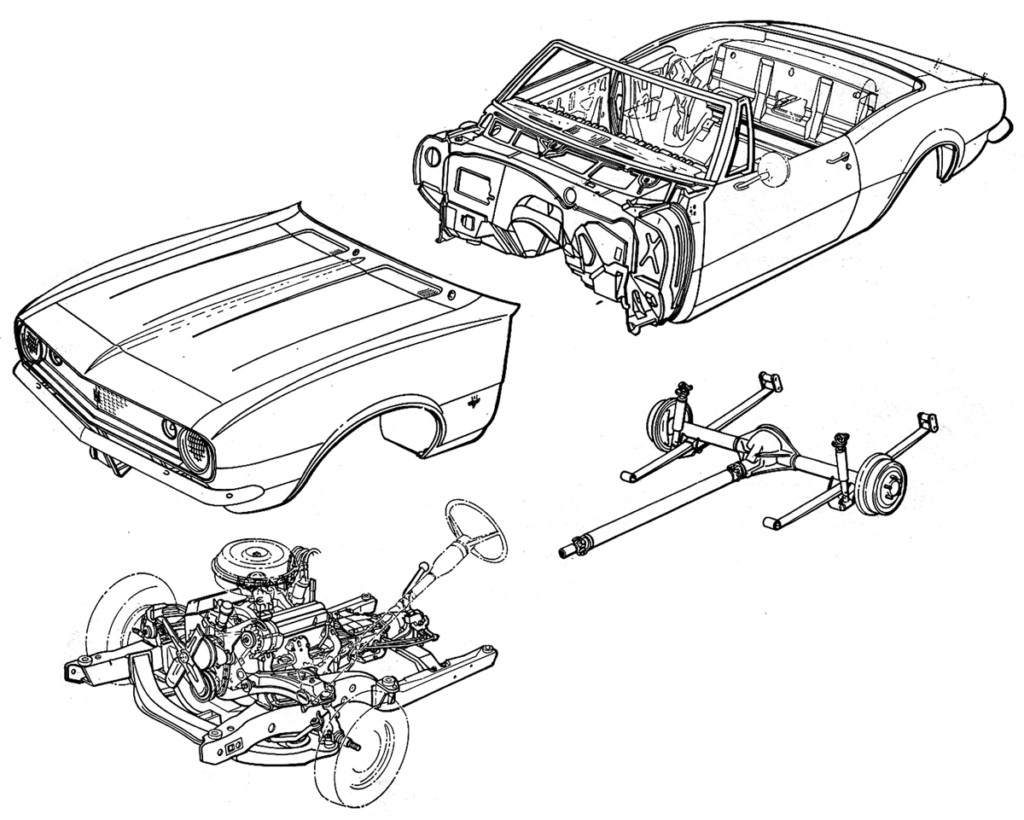
The main feature of the Camaro is the front module with suspension, steering, and engine, which are mounted on a subframe. The first-generation rear had mono-leaf springs, but they turned out to be too weak for the powerful engines. The choice of driving options was no less than that of the Mustang: engines, brakes, transmissions, suspensions.
The market warmly welcomed another café racer: from the start, more than two hundred thousand cars were sold. With the help of the Camaro, Chevrolet once again took first place in the US, but the pony car duel was still in favor of the Mustang.
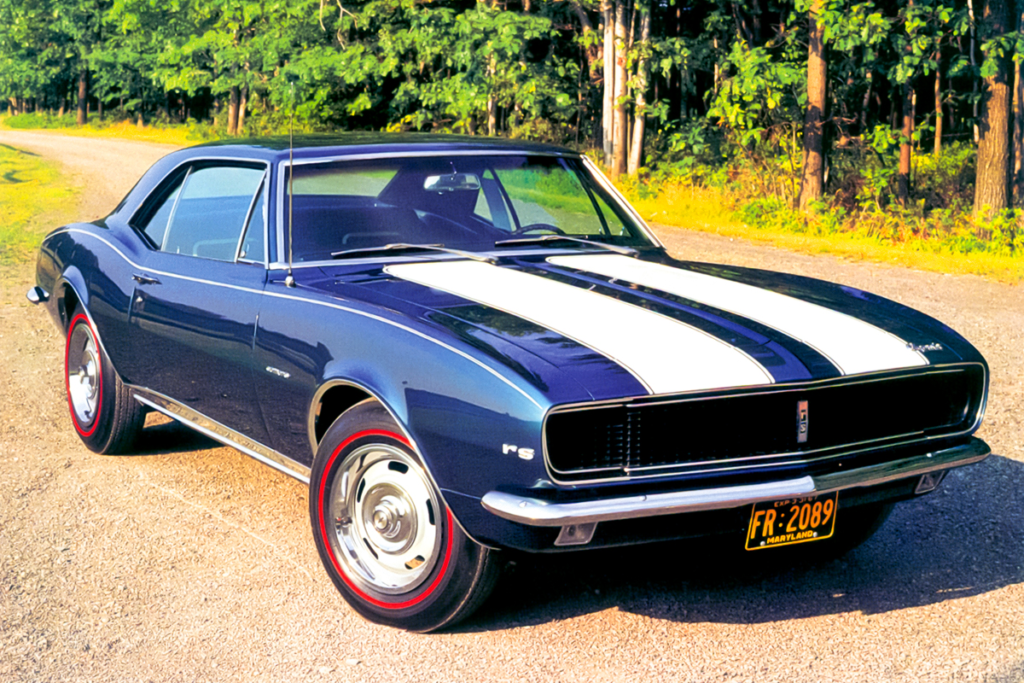
This is the first-generation Camaro in the RS version with headlights hidden behind the grilles.
In 1970, the second generation of Camaro appeared, which lasted on the assembly line for a full 12 years. The exterior changed radically, and technically it was almost the same car, except that multi-leaf springs appeared in the rear instead of mono-leaf springs. By the mid-seventies, the arms race turned around. Due to rising fuel prices, big-block engines disappeared from under the Camaro’s hood, and the power of the remaining engines dropped significantly. The number of versions was reduced, rear disc brakes were cut back to save costs – all signs indicated that the era of pony cars was coming to an end. But would you say that looking at the olive Camaro of 1978 in the Z28 version?

Luxurious design, targa body and stylish louvers on the rear window, akin to the early 90’s Ladas. Yes, there’s less aggression here compared to the first-generation models, under the hood included. If in the late 60s the small block 5.7-liter engine produced close to 300 horsepower, here it’s less than 200! The 0-60 mph acceleration time has increased from six seconds to nine – certainly not breathtaking. The three-speed automatic transmission takes its time to shift gears, as if preparing the driver for the next burst of acceleration. But without the Ford’s theatrics and with a much calmer soundtrack, the Camaro turned out to be a second faster than the Mustang!
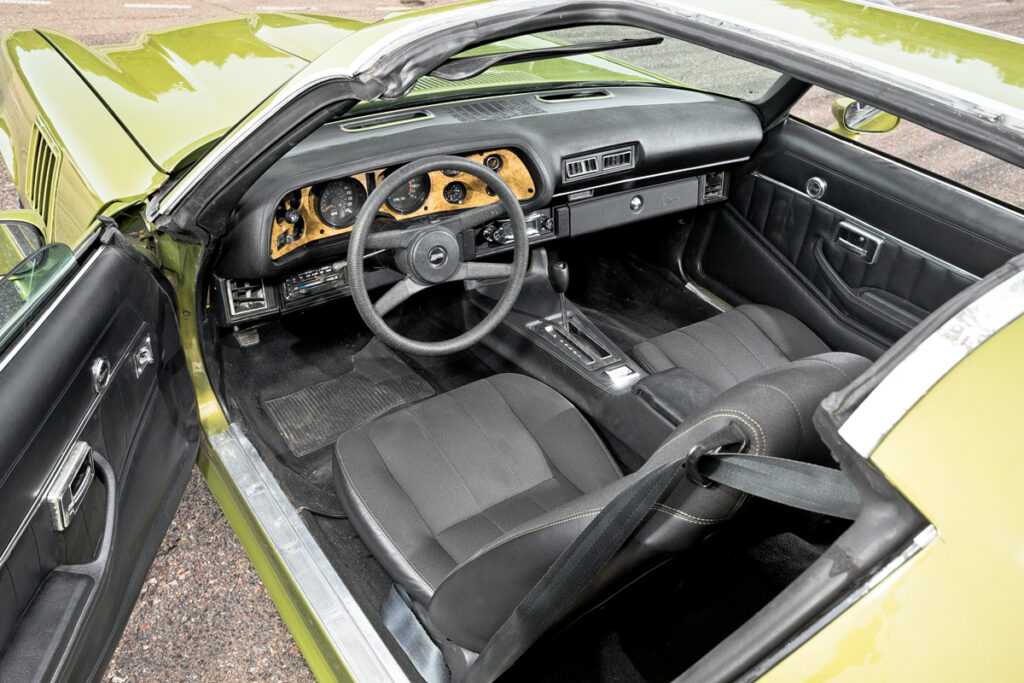
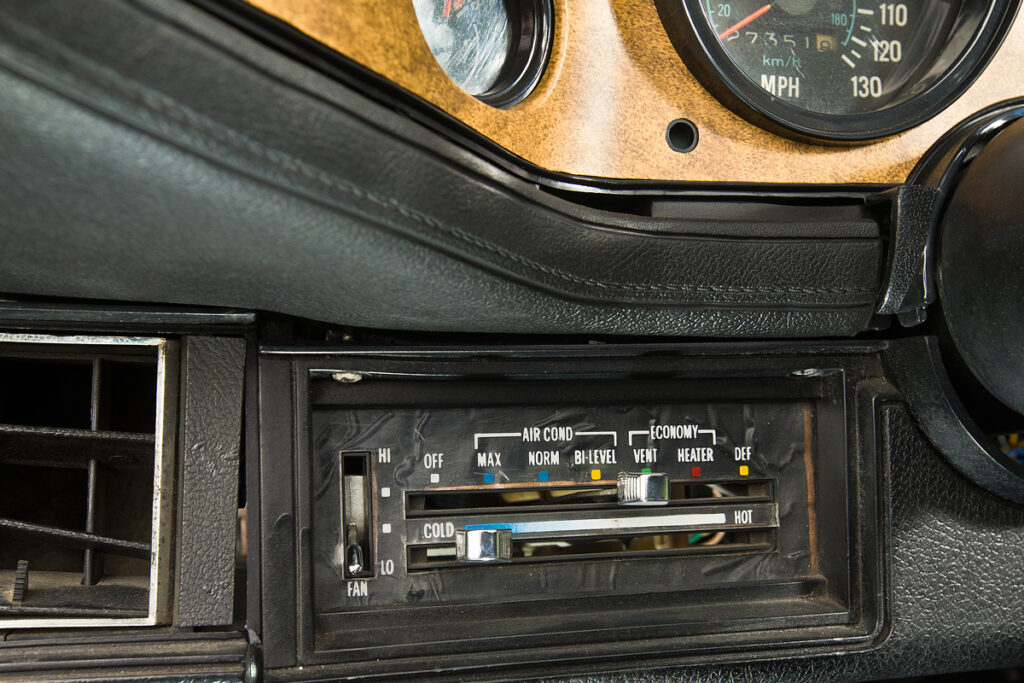
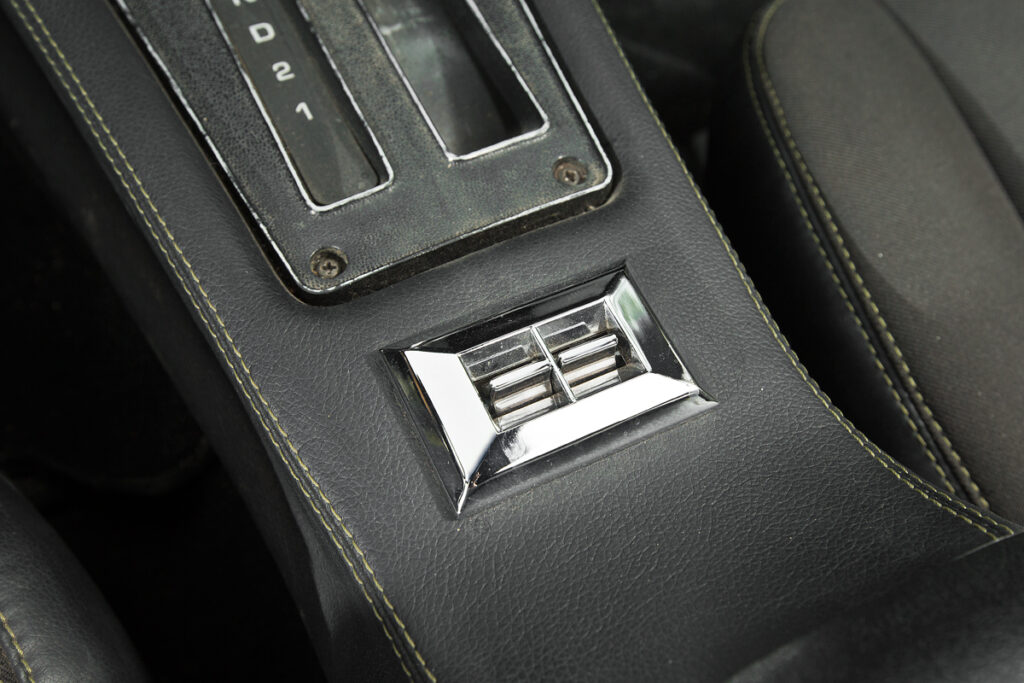
And the most important thing is that it takes corners in an interesting way. Precisely, the handling became the primary virtue of the revived Z28 version – this is the main racing abbreviation for Camaro in the late sixties. This mark was used for the homologated versions of the coupe with the famous 302 cubic-inch engine. In the metric system, this equals five liters and over three hundred horsepower. The engine revved up to 7,000 RPM, featured a raised compression ratio of 11:1, forged pistons, and mechanical valve lifters. The Camaro Z28 came with specialized springs, shock absorbers, and larger front brakes. Air conditioning was not an option you could order. In the second generation, the Z28 got a 5.7-liter engine, but it lost power year after year. The 1972 change particularly impacted the stats, as power output started being measured at the wheels, not at the flywheel. By 1979, it was down to just 175 horsepower, but Z28 turned from being an optional package designation into a separate version, and the Camaro finally managed to outdo the Mustang in sales.

Literally the dashboard. The gauges are easy to read, especially the prominent gear indicator for the automatic transmission. The emerald-green backlighting is reminiscent of a Volga, while the pale green in the Mustang resembles that of a Lada.
It all starts with the seating. Even though the interior materials are noticeably simpler than the Mustang’s, you sit in a much more human-like position. Very low, with legs stretched forward, and the vertical steering wheel can be adjusted for height! I swear – its almost like a single-seater racing car. There’s even a hint of lateral support, and the headrest is integrated into the seatback.
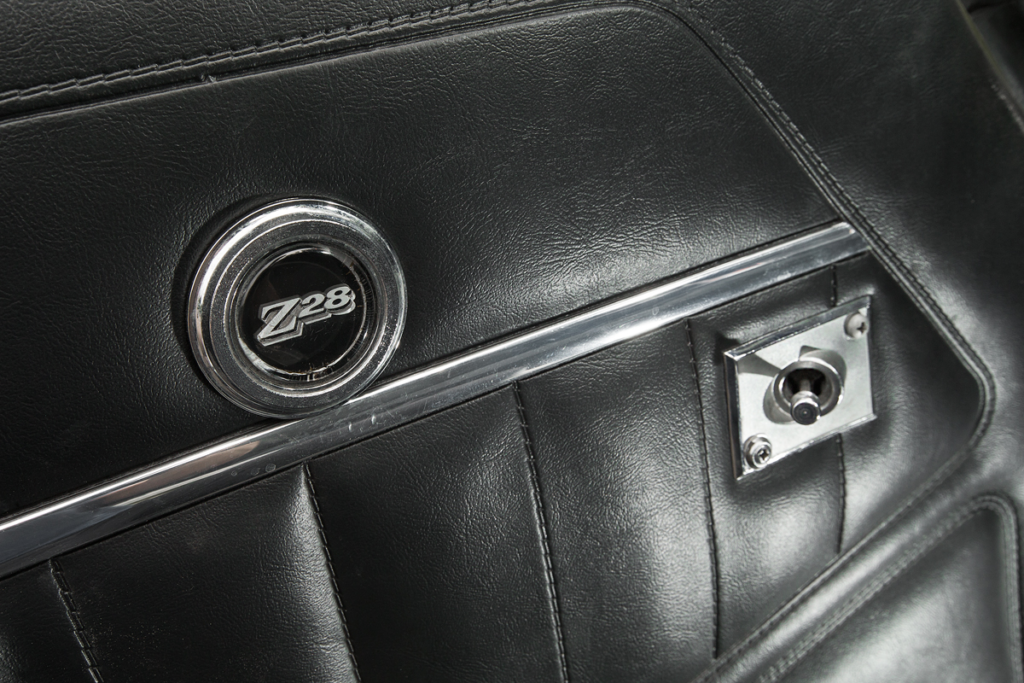
The steering is significantly quicker – 2.7 turns lock-to-lock, and as soon as you take up the slack around the center, the Camaro becomes incredibly responsive! Each turn is an event, as the driver’s seat is almost at the rear wheel and the hood is very long. At first, you look through the low windshield as the Camaro seems to rotate around you, and in a second, you’re also moving sideways – it’s a drift! This Chevrolet doesn’t lack cornering ability at all, but there’s no need to be alarmed by this setup, because with the right high-profile tires, the slide develops very smoothly. The Camaro amazingly hangs at a slight angle and gently straightens up on exit. This is where a comparison with the BMW M3 E30, which has a similarly tuned chassis, is appropriate. Even on our traditional slalom, the tail whip in the second corridor is not scary – as if under the supervision of a stability control system, it turns out to be just what is needed to return to your lane. As for the Mustang with its stubbornness, just try making it change direction – you almost have to intercept a steering wheel just to change lanes.

Getting into the rear seats of the Camaro is not easy, nor is it comfortable to be there.
Meet the small block, one of the most famous and reliable engines in the world, which consumed almost 40 liters of gasoline over 120 kilometers of filming. And it’s totally worth it.
The Camaro has decent brakes: the pedal goes deep, but the deceleration is not scary. What surprised me was the smoothness of the ride. Even on chubby tires, the Chevrolet manically follows the road profile — you’re constantly bouncing, as if on a ball. But that’s about the only issue. Otherwise, the Camaro pleasantly surprised: not all pony cars are equally rough around the edges!
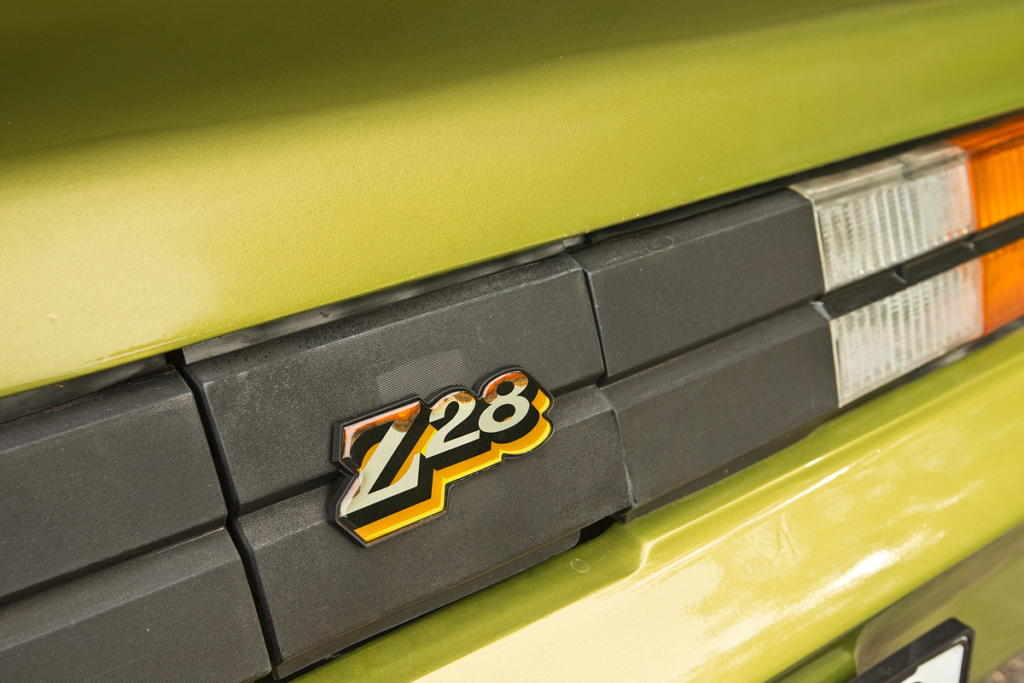
The little hatch under the trunk lid is almost like the ones in Moskvich cars — behind it, there’s the trunk lock cylinder and the fuel filler neck.
On the other hand, current buyers of these cars are looking for wildness and ruggedness. They want to feel like a 60s movie star through sheer force and effort, and make heads turn. After all, it’s not that difficult to make the Mustang drive well: the restomod trend, where a modern suspension and rack-and-pinion steering are hidden under the original exterior, is gaining momentum in Russia. And if a good Mustang or Camaro costs around two to three million rubles, a quality restomod is already five to seven million. A tangible price for a unique car with 60s charisma that you can easily drive daily.

But why? A conventional Camry will still be more comfortable and trouble-free, and the degree of emotion in the “tamed” American classics is not the same anymore. So, let me dance on the pedals of a real Mustang one more time. To go back to the times when the roads in the US were the most dangerous in history — from the dawn to the dusk of the muscle car era.
Photo: Dmitry Pitersky
Expert group: Andrey Mokhov | Yaroslav Tsyplenkov
This ia a translation. You can read the original articlet here: От рассвета до заката: знакомимся с пони-карами Ford Mustang и Chevrolet Camaro

Published June 21, 2023 • 13m to read

